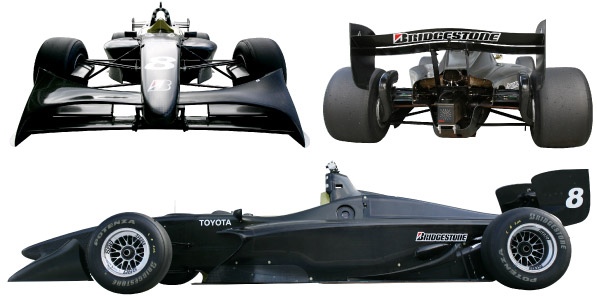
Formula NIPPON machine
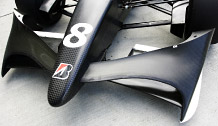 The machine used in Formula NIPPON is the "FN09" specially developed according to a new regulation by America's Swift Engineering.
The machine used in Formula NIPPON is the "FN09" specially developed according to a new regulation by America's Swift Engineering.
As with all the latest formula cars, the main monocoque shell is made of carbon composite with the engine mounted in the rear with a stressed mount system. It is a basic construction that is comparable to F1 machines in terms of safety and performance.
Outstanding aerodynamics
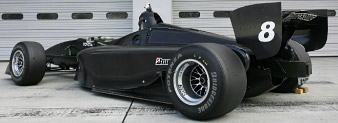 The new machine is distinctive by its exterior appearance. Mounted on the front end of the machine is a twin-wing device that is rare among the world's formula cars. The wing end plates and the upper and lower wings are connected by smoothly curved surfaces that create a unique futuristic look. This wing also performs a shock-absorbing function in the case of a collision for improved safety as well.
The new machine is distinctive by its exterior appearance. Mounted on the front end of the machine is a twin-wing device that is rare among the world's formula cars. The wing end plates and the upper and lower wings are connected by smoothly curved surfaces that create a unique futuristic look. This wing also performs a shock-absorbing function in the case of a collision for improved safety as well.
Another distinguishing feature of the FN09 besides its front wing is the structure called side ports on the sides of the machine. These ports house the engine radiator and other functions, and they also serve an aerodynamic function.
Characteristics that test the driver's skills
The side ports on the FN09 are positioned higher than on other formula cars. This creates a greater sense of volume to the machine that makes it especially impressive in action, but this design is not purely for appearance. It also function to direct airflow along the sides of the machines efficiently toward the rear in a way that effectively creates down-force that contributes to better handling stability.
Also, although it cannot normally be seen from the outside, the lower surface of the side port has a reverse wing shape that flares up toward the rear. This creates a rapid flow of air between the lower edge of the side port and the track surface when the machine is running and draws it out through the rear of the machine. This creates a suction force between the machine and the track surface and functions as down-force that contributes to handling stability. This kind of machine design that uses the shape of the lower surface of the side port to create downward suction when running is called a "venturi car" or "wing car." The venturi car design increases running performance so much that it is banned in F1, but thanks to a strong concern for safety in the FN09 design, it is a full-fledged and viable venturi car.
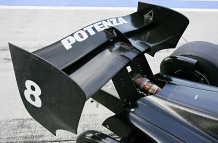 The battles are sure to intensify
The battles are sure to intensify
The increased down-force has made it possible to increase the cornering stability of the FN09 and increases the possibilities for a driver to pass the machine in front. And this will surely lead to fierce battles on the track in races as the drivers push the limits of their driving technique.
Unified basic specs
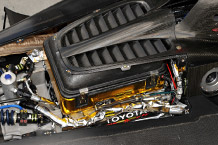 Since 2006, Toyota and Honda have supplied original 3000cc racing engines in their respective RV8J and HF386E engines for Formula Nippon machines, but with the new regulation from 2009 both makers will be supplying newly developed 3400cc V8 race engines to mount on the Swift chassis.
Since 2006, Toyota and Honda have supplied original 3000cc racing engines in their respective RV8J and HF386E engines for Formula Nippon machines, but with the new regulation from 2009 both makers will be supplying newly developed 3400cc V8 race engines to mount on the Swift chassis.
For many years Formula NIPPON has been competed with engines of a 3000cc displacement. However, recent advances in race technology have led to the conclusion that the 3400cc V8 format is the most efficient for delivering high performance, while also providing the potential for use in other categories.
Toyota and Honda are the two engine suppliers
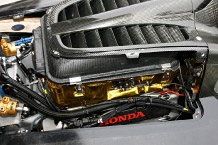 The designation of the engine supplied for Formula NIPPON by Toyota is RV8K, and this is the same engine that will be used in SUPER GT machines. In that case the proposed engine name is RV8K-G.
The designation of the engine supplied for Formula NIPPON by Toyota is RV8K, and this is the same engine that will be used in SUPER GT machines. In that case the proposed engine name is RV8K-G.
The name of the engine Honda supplies is HR09E. This engine has also been designed with the possibility of use in other categories, but as of 2009 there are no specific plans to use it categories other than Formula NIPPON.
Equal conditions maintained despite different engine characters
Both of these engines use the latest technologies to achieve lightweight, compact designs that deliver over 600 hp with an engine weight of approximately 120 kg. In Formula NIPPON the machines are fitted with a rev-limiter that maintain a maximum of 10,300 rpm and help ensure that performance does not exceed a prescribed level so that it is eventually the technique of the drivers that decides the outcome of the race. This also serves to limit engine wear and thus reduce maintenance cost.
These engines are supplied by the makers initially to the administrative body Japan Race Promotion (JRP) and distributed to the various teams after maintenance. This is another regulation aimed at maintaining fairness in competition. Also, as a measure to prevent excessive engine development competition and the cost that involves, a regulation change for 2009 says that one engine must be used for at least four races (vs. 3 races in 2008). If engine trouble or other circumstances require that an engine be changed before funning four races, the team will be penalized by having their qualifying position dropped 10 places for the race at which the change occurs. However, if the engine trouble occurs during a race and the team is unable to finish that race as a result, no penalty will be applied.




